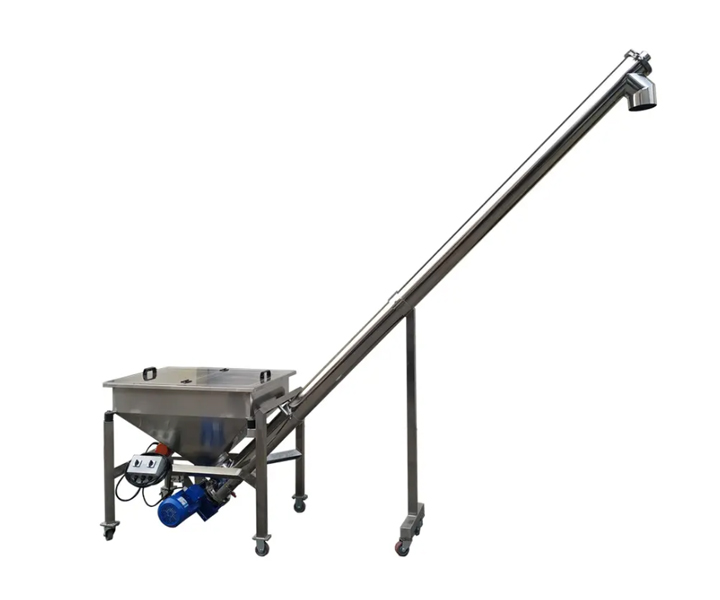
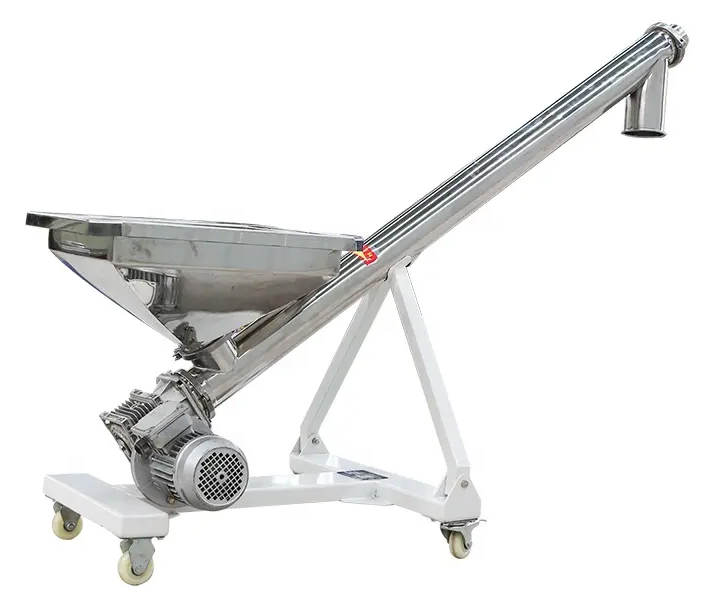








Moving powder or granular material from one location to another within a manufacturing or processing facility
![]()
![]()
![]()
Price:$565.00 - $6,282.00/ Set
Consult now and enjoy a 10% discout
Diameter: 114, 113, 159mm
Hopper volume: 100L
Conveying height: ≤8 meters
Conveying capacity: 1000kg/h Speed: 1450 rpm
Motor power: 1.5KW-6KW
Power supply: three-phase, 220v/240v/380v/415v/440v 50HZ
Application: Widely used in food and beverage, pharmaceutical, chemical processing and other industries, conveying flour, spices, powdered sugar, lime powder, powdered sugar, metal powder, pharmaceutical powder, cement powder and other powders
Commitment:Free Shipping/5 Days Delivery/30-Day Returns/Support Customization
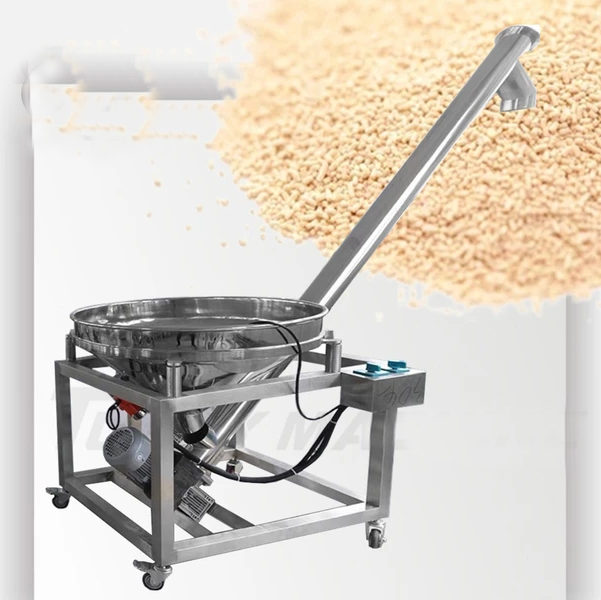
A powder conveyor is material handling equipment designed to move powdered or granular materials from one location to another for handling a variety of powders including fines, coarses, abrasives, Crushed powder, widely used in food and beverage, pharmaceutical, chemical processing and other industries.
The hopper of the powder conveyor is equipped with stainless steel grilles to ensure the safety of workers and prevent oversized particles from entering the conveyor. The hopper and conveying pipes are made of stainless steel (material according to customer requirements) to ensure that the raw materials are completely pollution-free during transportation , The conveying pipeline adopts a closed design, which can effectively prevent dust, and can be matched with a packaging machine to form a complete automatic packaging production line.

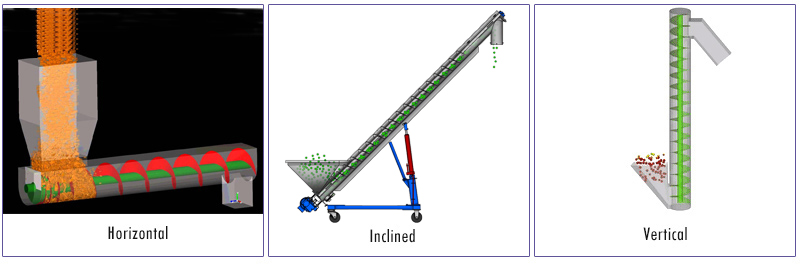
The purpose of a powder conveyor is to move powder or granular material from one location to another within a manufacturing or processing facility, ensuring that the powder or granular material passes through the manufacturing or processing facility efficiently and safely. The specific function may vary by application, but some Common features include:
Transport: Transporting powder or granular material from one location to another, such as from a storage silo to a packaging machine.
Metering: Can be used to control the flow rate of the material, ensuring that the correct amount of powder is delivered to the processing or packaging machine.
Mixing: Used to mix or blend powders as they are conveyed, ensuring a uniform final product.
Drying: Can be used to move wet material during drying, for example in the production of milk powder or other dairy products.
Cooling: Can be used to move hot materials through cooling processes, for example in the production of hot cereal or other food products.
There are several methods of powder conveying that are commonly used in the processing industries. The choice of method depends on a number of factors, including the properties of the powder being transported, the distance and route of the transport, and the desired flow rate. Some common methods of powder conveying include:

PowderScrew Conveyor
This method uses a rotating screw to convey powder along a trough or tube for adding small amounts of powder, unloading bulk bags, unloading small hoppers and other different types of applications.
Application: flour, spices, powdered sugar, lime powder, cement powder, etc.
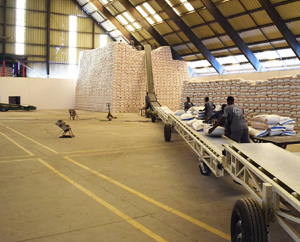
Powder Conveyor Belt
This method uses a belt to convey powder along a flat or inclined surface, often used for horizontal conveying, and can handle bulk powder or bagged powder, such as flour, bagged flour, etc.
Application: flour, bagged flour, putty powder, mineral powder, etc.
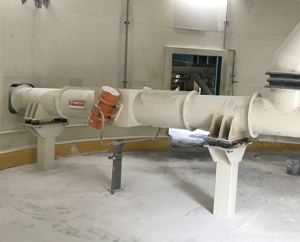
PowderVibrating Conveyor
This method uses vibration to convey powder along troughs or tubes. These systems are highly hygienic and gentle, and are useful for conveying dry, wet, frozen and abrasive powder products.
Application: flour, wood chips, quartz powder, carbon powder, etc.
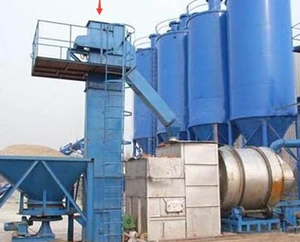
PowderBucket Elevator
This method uses a series of buckets to convey powder along a vertical or inclined path and is often used to lift powder to a higher height, such as loading material into a silo.
Application: gypsum powder, cement powder, fly ash, mineral powder, etc.

Powder conveyors are commonly used in food, pharmaceutical, chemical and other industries to move powders and other materials from one location to another, and can handle a variety of powders, including:
Fine Powders: Includes powders with a particle size of less than 100 microns, such as flour, sugar, and spices.
Meal: Includes larger particle size powders such as cement, sand, and fertilizers.
Abrasive Powders: Includes powders that can cause wear and damage to conveyors, such as silica, alumina, and metal powders.
Hygroscopic powders: Includes powders that absorb moisture easily, such as salt, baking soda, and milk powder.
Fragile powders: Includes powders that are easily broken or degraded, such as medicinal powders and powdered detergents.
Versatility
Can be customized to handle a wide variety of powder products including fine powders, coarse powders and abrasive powders.
Automation
There is a time setting in the system, and the feeding amount can be set according to each feeding amount.
Improve efficiency
Designed to convey powder over long distances and at high flow rates, it can be automated, reducing the need for manual labor and increasing productivity.
It is not easy for sundries to enter
The hopper is equipped with a stainless steel grille to prevent oversized particles from entering the conveyor and also prevent damage to the conveyor and downstream equipment.
Reduced risk of product contamination
The hopper and screw are made of stainless steel for easy cleaning, which minimizes the risk of product contamination.
Reduce maintenance
Low maintenance and can be designed to minimize wear and tear, reducing the need for frequent maintenance and downtime.
| Model | Vertical height | Motor power | Feed opening size | Tube length | Transfer speed | Tube diameter |
| LS-1 | 1.8-2.0m | 1.5Kw | 835x800mm | 2623mm | 1000-3000Kg/h | 114mm |
| LS-2 | 2.2-2.4m | 3095mm | ||||
| LS-3 | 2.6-2.8m | 3566mm | ||||
| LS-4 | 3.0-3.2m | 4038mm | ||||
| LS-5 | 3.4-3.6m | 4510mm | ||||
| LS-6 | 3.8-4.0m | 2.2Kw | 4981mm | |||
| LS-7 | 4.2-4.4m | 5453mm | ||||
| LS-8 | 4.6-4.8m | 5924mm | ||||
| LS-9 | 5.0m | 6160mm |
Selecting the right powder conveyor for your application can be a complex process, with several factors to consider:
Material Properties: The properties of the powder being conveyed, such as particle size, density, moisture content and flow characteristics, will determine the type of conveyor best suited for the application.
Capacity: The required capacity of the conveyor depends on the flow rate of the powder and the distance it needs to be conveyed.
Operating environment: The operating environment, such as temperature, humidity, and the presence of corrosive or abrasive materials, can affect the selection and construction of conveyor materials.
Space Constraints: The space available on the conveyor will determine the size and configuration of the conveyor, and the type of drive system best suited for the application.
Safety: The safety of the conveyor should be considered, including guards, emergency stops, and safety interlocks to ensure safe operation.
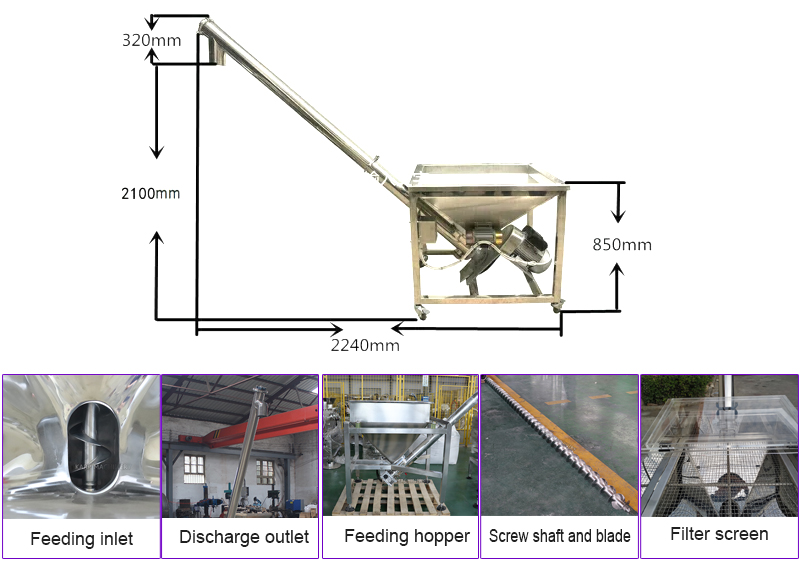
Screw or Helical Blade: This is the main part of the conveyor and is responsible for conveying the powder. Screws are usually made of metal and have a helical shape wrapped around a central axis.
Housing: The housing is usually made of metal and shaped like a slot or tube. It contains the screw and provides support for the conveyor.
Inlet and Outlet: The inlet is where the powder is loaded into the conveyor and the outlet is where the powder is discharged. Depending on the application, the inlet and outlet can be located at different locations along the length of the conveyor.
Bearings and Seals: Bearings support the rotation of the screw, while seals prevent powder leakage from the housing.
Drive Mechanism: The drive mechanism turns the screw and is usually located at one end of the conveyor. It can be powered by an electric motor or another source of power.
Controls: Controls are used to start and stop the conveyor, regulate the speed and flow of powder, and monitor the operation of the conveyor.
Powder conveyors can be customized to meet the specific requirements of the application, here are some common options available:
Screw Design: Screws can be designed with different pitches, diameters and flight configurations to optimize powder flow and transfer.
Housing Design: Housings can be customized in different shapes and sizes to meet specific application requirements.
Materials of Construction: The screw and housing can be made of different materials such as carbon steel, stainless steel or plastic to meet the requirements of the application.
Inlet and Outlet Options: Inlets and outlets can be customized in different configurations and sizes to meet application specific loading and unloading requirements.
Feeder: A feeder can be added at the inlet of the conveyor to regulate the flow of powder into the conveyor.
Covers and Dust Collection: Covers can be added to the conveyor to prevent dust and powder contamination. A dust collection system can also be added to the conveyor to control dust emissions.
Controls: Controls can be added to conveyors to automate conveyor operations and monitor conveyor performance.


Address:China,Yanjin county forest park gate to the west 1000 meters north road.